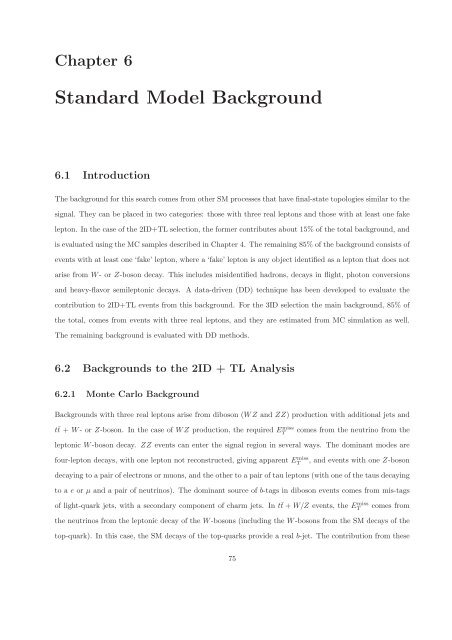CERN-THESIS-2012-153 26/07/2012 - CERN Document Server
CERN-THESIS-2012-153 26/07/2012 - CERN Document Server
CERN-THESIS-2012-153 26/07/2012 - CERN Document Server
Create successful ePaper yourself
Turn your PDF publications into a flip-book with our unique Google optimized e-Paper software.
Chapter 6<br />
Standard Model Background<br />
6.1 Introduction<br />
The background for this search comes from other SM processes that have final-state topologies similar to the<br />
signal. They can be placed in two categories: those with three real leptons and those with at least one fake<br />
lepton. In the case of the 2ID+TL selection, the former contributes about 15% of the total background, and<br />
is evaluated using the MC samples described in Chapter 4. The remaining 85% of the background consists of<br />
events with at least one ‘fake’ lepton, where a ‘fake’ lepton is any object identified as a lepton that does not<br />
arise from W- or Z-boson decay. This includes misidentified hadrons, decays in flight, photon conversions<br />
and heavy-flavor semileptonic decays. A data-driven (DD) technique has been developed to evaluate the<br />
contribution to 2ID+TL events from this background. For the 3ID selection the main background, 85% of<br />
the total, comes from events with three real leptons, and they are estimated from MC simulation as well.<br />
The remaining background is evaluated with DD methods.<br />
6.2 Backgrounds to the 2ID + TL Analysis<br />
6.2.1 Monte Carlo Background<br />
Backgrounds with three real leptons arise from diboson (WZ and ZZ) production with additional jets and<br />
t¯t + W- or Z-boson. In the case of WZ production, the required E miss<br />
T<br />
comes from the neutrino from the<br />
leptonic W-boson decay. ZZ events can enter the signal region in several ways. The dominant modes are<br />
four-lepton decays, with one lepton not reconstructed, giving apparent E miss<br />
T , and events with one Z-boson<br />
decaying to a pair of electrons or muons, and the other to a pair of tau leptons (with one of the taus decaying<br />
to a e or µ and a pair of neutrinos). The dominant source of b-tags in diboson events comes from mis-tags<br />
of light-quark jets, with a secondary component of charm jets. In t¯t + W/Z events, the E miss<br />
T<br />
comes from<br />
the neutrinos from the leptonic decay of the W-bosons (including the W-bosons from the SM decays of the<br />
top-quark). In this case, the SM decays of the top-quarks provide a real b-jet. The contribution from these<br />
75















